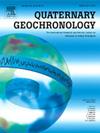分析用于冰川沉积物发光测年的复杂单颗粒长石当量剂量分布
IF 2.5
2区 地球科学
Q3 GEOGRAPHY, PHYSICAL
引用次数: 0
摘要
过深谷是冰川冲刷到下层基底的结构,随后被沉积物填满,记录了附近地貌的环境历史。本文研究的是德国南部巴伐利亚州弗赖拉辛(Freilassing)以西萨尔扎赫古冰川下形成的过深结构。在之前的研究中,采用多晶粒方法测定了岩心下部的无限红外激发发光(IRSL)年龄。采用单粒度长石发光测年法可以识别出之前被多粒度信号平均法掩盖的不饱和信号。通过识别等效剂量(De)分布中的正态分布前缘,可以剔除那些似乎反映了低估离群值的低值 De(LOVED)晶粒。对沿岩心全长分布的 11 个样本进行测量,得出了两个不同的年龄群,其衰减校正 IRSL50 年龄和未校正 pIRIR225 年龄在不确定范围内一致。研究结果表明,单颗粒 pIRIR 测量结果可用于解析阿尔卑斯山超深构造的填充年代学,至少可用于最近约 200 ka 的年代学研究。总之,本研究在理解和处理单颗粒长石发光测年中经常遇到的复杂 De 分布方面又迈进了一步。这有助于更好地理解经常观察到的单颗粒和单等值测量之间的年龄偏移。本文章由计算机程序翻译,如有差异,请以英文原文为准。
Analyzing complex single grain feldspar equivalent dose distributions for luminescence dating of glacially derived sediments
Overdeepened valleys are structures scoured into the underlying substrate by glaciers that have been subsequently filled with sediment, which recorded the environmental history of the adjacent landscape. Investigated here is an overdeepened structure that was formed beneath the Salzach Paleoglacier west of Freilassing, Bavaria (southern Germany). In a previous study, infinite infrared stimulated luminescence (IRSL) ages have been determined for the lower part of the core using a multi-grain approach. Applying single-grain feldspar luminescence dating allows to identify the unsaturated signals, previously masked by multi-grain signal averaging. Identification of the normally distributed leading edge in equivalent dose (De) distributions allows for the dismissal of low value De (LOVED) grains that appear to reflect underestimating outliers. Measurement of eleven samples distributed along the entire length of the core yielded two distinct age clusters, for which fading corrected IRSL50 and uncorrected pIRIR225 ages agree within uncertainties. Whereas the younger age cluster at the top of the sequence is attributed to Marine Isotope Stage (MIS) 3, the older age cluster is assigned to MIS 6. It is shown that single grain pIRIR measurements will allow to resolve the infill chronology of overdeepened structures in the Alps, at least for the last ca. 200 ka. Overall, the present study represents a further step towards understanding and handling complex De distributions often encountered in single grain feldspar luminescence dating. This contributes to better understand the frequently observed age offset between single grain and single-aliquot measurements.
求助全文
通过发布文献求助,成功后即可免费获取论文全文。
去求助
来源期刊

Quaternary Geochronology
地学-地球化学与地球物理
CiteScore
4.40
自引率
22.20%
发文量
130
审稿时长
20 weeks
期刊介绍:
Quaternary Geochronology is an international journal devoted to the publication of the highest-quality, peer-reviewed articles on all aspects of dating methods applicable to the Quaternary Period - the last 2.6 million years of Earth history. Reliable ages are fundamental to place changes in climates, landscapes, flora and fauna - including the evolution and ecological impact of humans - in their correct temporal sequence, and to understand the tempo and mode of geological and biological processes.
 求助内容:
求助内容: 应助结果提醒方式:
应助结果提醒方式:


